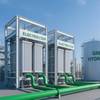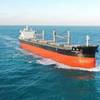Teijin SCR Helps Ships Cut NOx Emissions
Teijin Engineering Ltd. announced its development and launch of a selective catalytic reduction (SCR) denitration device for midsized ship engines to ensure compliance with the Tier III NOx (nitrogen oxides) Emissions Regulation that is slated to be enforced by the International Maritime Organization (IMO) beginning in 2016.
Teijin Engineering will initially supply the device on an OEM basis in June to Niigata Power Systems Co., Ltd., an engine manufacturer and the codeveloper of the product. Going forward, Teijin Engineering plans to expand sales to other ship engine manufacturers, targeting annual sales of $25 million by 2016.
The new SCR denitration device detoxifies emissions by mixing ammonia or liquid urea with exhaust gas that contains NOx and then passing the mixture through a catalytic layer to break down the NOx into nitrogen and water. Actual ship tests have demonstrated that the device can reduce NOx emissions by 80%.
Liquid urea is sprayed into the exhaust gas with high efficiency even as engine performance varies due to ocean swells and other navigational conditions. Oscillation and vibration are carefully analyzed to optimally position the catalytic layer for maximum NOx reduction. The device’s compact design enables installation in space-limited engine rooms, and with flexibility to ensure easy access when changing the catalyst.
Teijin Engineering has developed and marketed denitration devices for land-based equipment, primarily for in-house power generation at factories. With the new SCR denitration device, the company is now expanding into the ship-engine field to support efforts to clean up offshore environments.
The IMO, which has been tightening NOx emissions regulations for ships, beginning in 2016 will require compliance with the new Tier III Emissions Regulation, which calls for an 80% reduction of NOx emissions relative to the Tier I regulation. Compliance simply by attempting to improve engine combustion is considered unrealistic, so the demand for post-treatment of exhaust gas with denitration devices is expected to rise.










